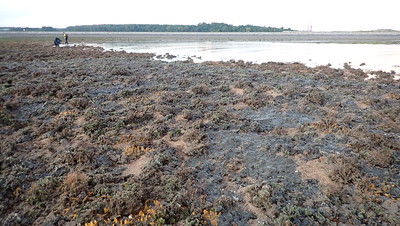Today, there is thankfully, no sign of mass coral bleaching. The patch rich with delicate colourful animals is still there, but the patch seems smaller with every visit. It was nice to see that seagrasses are more abundant on the now soft silty shore.
Today, the rich variety of sponges was only seen at the low water mark.
Quite a large area of the flats from the low water to the mid water mark was covered with dense growths of only Yellow bumpy sponges. Very few other sponges were seen among them.
Some areas were also heavily coated in Melted chocolate sponge.
Sponges means sponge-eating animals like nudibranchs! Today I saw this Ceratosoma gracillimum which seemed to be eating a black sponge (it was nestled in a hole chomped out in the sponge). And I also saw the white Jorunna funebris near the bright blue sponge that it is said to prefer to eat.
Dr Jani Tanzil alerted us that mass coral bleaching may have started on our shores since the second week of June. So I check up on the hard corals at Beting Bronok. There are a surprising number of small colonies of Boulder pore corals and Branching pore corals and tiny patches of Neat hexa corals. They were mostly alright, some with small dead patches or pale edges. Here's a compilation of some of the hard corals I saw, with a ruler for further study by others. It was tricky taking the photos in the dark in a drizzle.
Today I saw a few small Spiky flowery soft corals, none of them were bleaching. I noticed a False cowrie in one when processing the photos - this snail looks like the soft coral and eats it. But I did not see any Ball flowery soft corals or Pink flowery soft corals. I only saw two small sea fans: one Candelabra sea fans and one Asparagus sea fan, although the rest of the team saw more. I saw more sea fans and larger ones at Changi yesterday! I saw one Flowery sea pen. There were a lot of large Stinging hydroids as well as many other branching cnidarians. The rest of the team saw a few sea anemones of various kinds.
Other interesting encounters include this Brown stripe flatworm that appears to be eating a colonial ascidian.
The rest of the team saw many other different kinds of flatworms.
This shore used to be rich in echinoderms. These seem to be fading away. It seems every year, we see fewer and fewer echinoderms. Much less today compared to our survey in Jul 2019, which was already fewer than in Jun 2018. I saw only two large Biscuit sea stars, a few Orange sea cucumbers, and two Beige sea cucumbers. We didn't see any Knobbly sea stars and the large Thorny sea urchins seemed to have finally given up as we saw none.
It was a nice to see that Spoon seagrasses have spread to large parts of the silty soft centre of the southern part of the flats. I saw Spoon seagrasses with small and large leaf blades most were quite free of epiphytes. This is similar to our survey in Jun 2018, and better than what I saw in Jul 2019 when they were heavily covered in ephiphytes. I also came cross a small patch of Hairy spoon seagrass which I saw in Jun 2018 and Jun 2017.
There seems to be a mild bloom of Sea lettuce (Ulva) that entangled many clumps of sponges. There were also lush clumps of Caulerpa peltata on some parts of the shore, and a variety of other seaweeds too.
A hole in a submerged flat is usually the result of a boat striking it at high tide. Today, however, we are glad to have not encountered fish traps or nets on the flats.
Sunrise is always a glorious experience on Beting Bronok. Our trip started in a drizzle with distant lightning, but cleared for a spectacular sunrise behind tall clouds. Thanks to NParks for permission to survey and Chay Hoon for organising the logistics.
Where is Beting Bronok? What is it's status and future?
When the 2030 landuse plan by the Ministry of National Development was announced, it was also announced that Beting Bronok and Pulau Unum have been granted 'Nature Area' status. As I understand it, this status means the area "will be kept for as long as possible until required for development". Here's an earlier about 'Nature Area' status seem to mean.
To me, Beting Bronok seems to be in steady decline since the reclamation started at nearby Pulau Tekong . It has since also been affected by the flooding that led to mass deaths at Chek Jawa in 2007, and the coral bleaching in 2010 and a ferry ran aground on Beting Bronok in Jul 2011. Development of Pengerang Johor for a petrochemical complex that was rejected in Taiwan for environmental and health reasons can also impact Beting Bronok.
Now, with massive reclamation at Tekong, we can only hope for the best for this wonderful reef on our Northern shore.
Posts by others on this survey
Loh Kok Sheng
Jianlin Liu
Vincent Choo
Chay Hoon
Surveys on other shores
Richard Kuah surveyed East Coast Park
Dayna Cheah surveyed Changi.
















